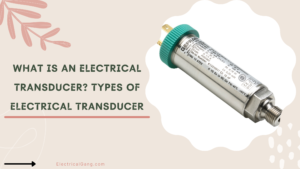
We all know that a transducer is an electrical device that we use to change the form of energy from one form to another. The form of energy can be in various ways such as electrical, mechanical, thermal, or optical, etc. The best example of a transducer is a microphone, loudspeaker, etc.
A loudspeaker is a type of transducer used to convert a low-frequency signal into an audible sound like a high-frequency signal. Similarly, a microphone is a type of transducer that converts the variation of sound pressure into current into voltage.
Therefore such transducers are considered as complementary transducers of each other. Transducers are also used as inputs as well as outputs in electronic circuits. In an audio system, for example, a loudspeaker is used as an output. Similarly, in a recording system, a microphone is used as an input transducer.
In today’s article, we will see what is an electrical transducer. What are the types of these electrical transducers? And Today we will get information like what is the application of Electrical Transducer etc.
Suggested Read: What Is DC Generator? | Types of DC Generator
What is an Electrical Transducer?

The electrical transducer can be defined as a transducer. Which gives us electrical energy as its output. This transducer works to convert a form of energy into an electrical signal. The form of energy here can be light, heat, or sound and the electrical signal can be frequency, current, or voltage.
The production of this signal depends on the effects of resistance, capacitive and inductive. Non-electrical quantities can be measured using a detector that converts physical quantities into displacements to activate the transducer.
Types of Electrical Transducers:

Electrical transducers are classified into two types as follows:
| Sr. No. | Types of Electrical Transducers |
| #1. | Active Transducer |
| #2. | Passive Transducer |
#1. Active Transducer:
Another name for this transducer is a self-generating transducer. This transducer generates a voltage signal or a current signal. The energy required for the output signal output can be obtained. The energy required for the formation of this output signal is calculated from the physical phenomenon. The best examples of active transducers are thermocouples, PV cells, photoelectric cells, moving coil generators, piezoelectric transducers, etc.
Suggested Read:What Is Motor Winding? | Types of Motor Winding
#2. Passive Transducer:
A transducer that is driven by an external power is known as a passive transducer. Such a transducer receives the power required for energy conversion from an external energy source. Further, these transducers are classified into resistive, capacitive, and inductive. Resistive types mostly include thermistors, resistance stress gauges, and photoconductive cells. The stimulus type includes LVDT and the capacitance includes photoemissive and devices that depend on the hole effect.
Apart from this, there are optoelectronic transducers that work on the principle of converting energy from light to electricity. Some of the best examples of optoelectronic transducers are photovoltaic cells, photoconductive cells, solar cells, photomultiplier tubes, and photomultipliers.
How To Select The Perfect Electrical Transducer?
The following are important factors to consider when choosing the right transducer:
- Operating range: Range needs and selected to maintain good.
- Sensitivity: Selected to allow adequate output.
- Frequency response and resonant frequency: Flat on the entire desired range.
- Minimum sensitivity: For the expected stimulus, except the criteria.
- Environmental compatibility: Restrictions on temperature range, rusty fluid, pressure, shock, interaction, size, and mounting.
- Electrical parameters: Length and type of cable required, signal and frequency response limits of noise ratio when connected to amplifiers.
Advantages of Electrical Transducer:

The advantages of an electrical transducer are as follows:
- The extensive inactivation effect can be minimized.
- The effect of friction can be reduced.
- Any system can be managed with a low power level.
- The output can be specified and recorded at a distance from the sensing medium.
- The output is used only for transmission as well as for the measurement process.
- Attenuation can be done easily.
- The signal can be mixed or controlled to get any permutation with the output of the respective transducer.
Suggested Read: How to Reset Roku TV Without Remote in Just a Few Steps
Most Commonly Asked Questions:

What are the two types of transducers?
Electrical transducers are classified into two types as follows:
| Sr. No. | Types of Electrical Transducers |
| #1. | Active Transducer |
| #2. | Passive Transducer |
What is the function of an electrical transducer?
The transducer converts certain types of energy into sound sources or converts sound energy into an electrical signal.
What is a transducer give an example.
We all know that a transducer is an electrical device that we use to change the form of energy from one form to another. The form of energy can be in various ways such as electrical, mechanical, thermal, or optical, etc. The best example of a transducer is a microphone, loudspeaker, etc.
What are the advantages of an Electrical Transducer?
The advantages of an electrical transducer are as follows:
- The extensive inactivation effect can be minimized.
- The effect of friction can be reduced.
- Any system can be managed with a low power level.
- The output can be specified and recorded at a distance from the sensing medium.
- The output is used only for transmission as well as for the measurement process.
- Attenuation can be done easily.
- The signal can be mixed or controlled to get any permutation with the output of the respective transducer.
Like this post? Share it with your friends!
Suggested Read –